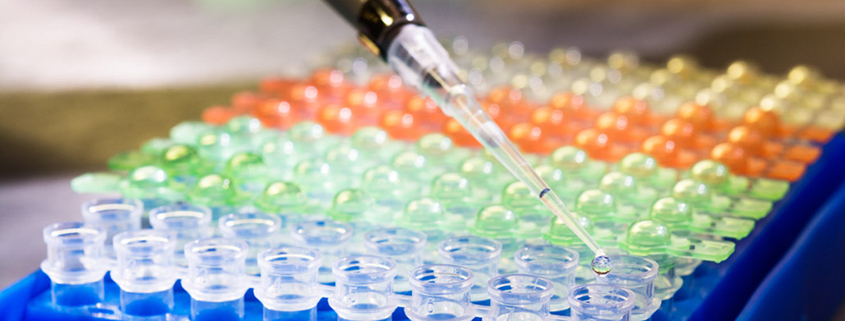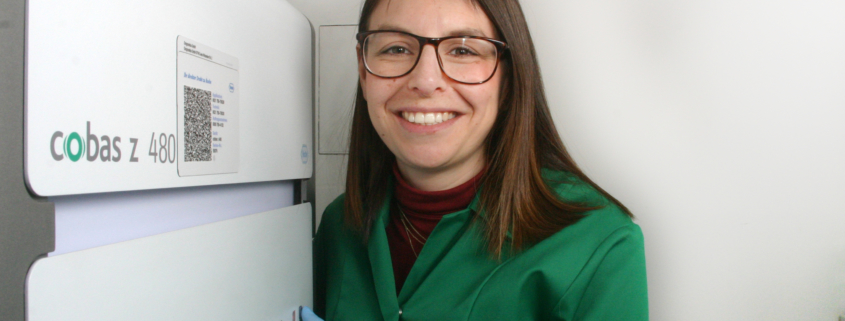The method of the PCR stands for the polymerase chain reaction. The underlying process has fundamentally changed medical and biotechnological research. It is now considered the most important laboratory method for investigating the molecular structure of our genetic material (= DNA). This is partly due to the fact that the PCR analysis is versatile. It is used in all oncgnostics projects and is an elementary part of our GynTect test for cervical cancer. However, the PCR test recently gained publicity through its use in the current worldwide testing of Corona.
What is PCR used for?
Laboratories use the methodology for amplifying DNA in the shortest possible time. Quick runs, so-called Fast-PCRs, take place within 10 minutes. Others last between one and two hours.
Take our cervical cancer test GynTect: The aim of the PCR is to find out whether certain, epigenetically modified gene sequences that only occur in cancer cells, are present. These are known as methylation of DNA.
In order to clarify this question via PCR based diagnosis, you need the following:
- DNA from the sample to be examined. The sample is taken at the gynecological practice where the affected woman is cared for.
- Nucleotides: These are the basic chemical building blocks of DNA which are needed to make copies of the given DNA strand.
- Polymerases: This is a class of enzymes that is essential for the replication of DNA.
- Specific primers: The artificially generated, short oligonucleotide chains serve as starting molecules for the polymerase. They dock on the DNA strand, marking the point at which the polymerase begins its work. Depending on which regions (= biomarkers) of the DNA are to be detected, other primers serve as keys for the PCR method.
- Finally, a buffer solution is needed in which the reaction runs and which keeps the pH during the reaction stable.
Polymerase chain reaction: Process in the thermal cycler
The replication of the DNA usually takes place in three steps in a so-called thermal cycler. This laboratory device regulates the exact temperatures during the biochemical reaction.
- The first step is denaturation. The sample is heated to 94-96 °C. This causes the two strands of the double-stranded DNA to separate from one another.
- For the second phase of primer hybridization, the sample is rapidly cooled down to 50-65 °C. The respective temperature depends on the primers used, which serve as specific keys as described above. The primers now dock at the suitable points on the two single strands of the DNA.
- In the final step of elongation, also called extension, the single strands of the DNA become double strands again. The temperature is increased again to 68-72 °C. The polymerase attaches to the small areas of double-stranded DNA that were created by the primers. With the help of the loose nucleotides, it completes the double strand.
In the last phase, around 500 base pairs are formed within 30 seconds. The length of the third step depends on the length of the DNA sequence to be examined. Once the third step is completed, a new PCR cycle starts. As a result, the DNA amount in the areas of the markers to be detected increases exponentially. More than one billion copies can be available after just 30 cycles. The entire process usually takes one hour.
Important: The DNA sample is only duplicated if it contains the gene sequence you are looking for. In the case of GynTect or Corona, the DNA sample would be positive in this case.
PCR for diagnostics: What happens when using GynTect?
When performing GynTect, we use the described procedure. If there is a methylation of DNA for the corresponding gene sequence, which occurs exclusively in cancer cells and cancer precursor cells, the DNA can be replicated using specific GynTect primers. The result is positive. In this case, the sample lights up.
A specific fluorescent dye is applied for the optical signal. In successive cycles, this is repeatedly stored in double-stranded pieces of DNA that the PCR generates. The more duplicated DNA there is, the stronger the light signal. The cycle from which the resulting luminous signal significantly exceeds the background light is called the Cycle threshold, also known as Ct. For the GynTect test, a certain amount of DNA methylation data is at least necessary for a sample to be recognized as positive. However, the proportion is less than one percent. For Corona PCR tests, some few viruses in a sample are required to yield a positive result. The lower the Ct value, the more viruses were present in the original sample.
If the sample is negative, no methylation of DNA is detected. In this case, the PCR does not generate any DNA fragments and the dye is not stored anywhere. Accordingly, the sample does not emit a light signal.
You can see the preparation of the PCR for GynTect in this video.
Advantage and history of the PCR analysis
The advantage clearly lies in its ease of use. The tool proves specific genetic information in an uncomplicated and targeted manner. Here it is key that the primers specifically recognize the target sequence. In the example of GynTect, we apply primers that only fit certain, in this case six different, gene regions, and the primers only fit if the regions were previously methylated.
Research into the diagnostic method dates back to the 1950s. In its present sense, it was invented in 1983 and only 10 years later, in 1993, it was awarded the Nobel Prize for Chemistry. Today, many different PCR thermal cyclers are used in most laboratories.


 oncgnostics GmbH
oncgnostics GmbH